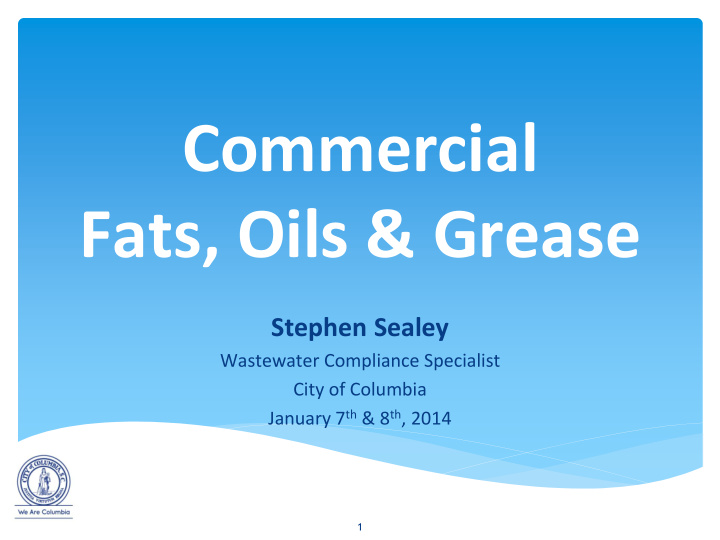



Commercial Fats, Oils & Grease Stephen Sealey Wastewater Compliance Specialist City of Columbia January 7 th & 8 th , 2014 1
What is FOG? Important Definitions ● Fat, oils, and grease (FOG) ○ Any liquid or solid material composed primarily of fats, oils, and grease from animal or vegetable sources 2
Important Definitions ● Food Service Establishment (FSE) ○ Any commercial facility that must install a Grease Trap or Grease Interceptor before discharging kitchen or food prep wastewater into the City’s wastewater system ○ Examples include (not limited to) ■ Restaurants ■ Motels/Hotels ■ Cafeterias ■ Hospitals ■ Schools ■ Bars ■ Any establishment required to have an SCDHEC food service license and/or permit ■ Any other facility at the sole discretion of the City 3
Reason For Program Grease is a PREVENTABLE maintenance issue = = 4
Reason For Program ● EPA Regulations: Clean Water Act 40 CFR 403 ● Protect City Assets ○ Sewer lines, Lift stations, Wastewater Treatment Plant ○ Average Cost of a grease related overflow (2 hours) exceeds $1,500 and includes the following equipment and personnel: ■ Stoppage Crew ■ Vactor Truck ■ CCTV Crew ■ Additional equipment and cleanup costs ● Protect the environment ○ Overflows can lead to water quality impacts, legal fees or fines 5
Important City Regulations ● Sewer Use Ordinance ○ FOG Limit of 100mg/L ○ Article IV Section 23-102 ● Engineering Regulation ○ Part 29: Fats, Oils & Grease Management Regulations ○ Part 30: Specifications for Grease Traps & Grease Interceptors 6
Important City Regulations: Part 29 ● In conjunction with City Ordinances, Chapter 23 ● What it does ○ Establishes uniform registration, operating, maintenance, cleaning, and inspection requirements ○ Designed to limit and control the discharge of fats, oils, and grease from Food Service Establishments (FSEs) into the City's wastewater collection system. ● Objectives: ○ Reducing fat, oils and grease from entering the city sewer lines and clogging or blocking lines causing backups ○ Establish a registration and GPS database for all FSE’s. 7
Important City Regulations: Part 30 ● What it does ○ Provide guidelines and requirements for design and installing grease traps and grease interceptors. ■ City Sizing requirements (4 options) ■ Grease trap design and specifications ■ Grease interceptor design and specifications 8
Registration Application 9
Grease Trap Sizing Guide Source: http://www.columbiasc.net/depts/utilities-engineering/docs/ww/uefilewwgreasetrapsizingguide.pdf
City Designs 11
Sizing Example: Typical Restaurant ● Inspectors survey to collect information based on sizing guide ● Typical Restaurant Example (cooking intensive) ○ Information collected ■ 120 seats ■ Open 10 hours a day ■ Flow Rate = 25 (Cooking intensive with washable dishware) ○ Option B: Cooking Intensive Establishment ■ = # seats x Flow Rate x (Hours of operation / 18) ■ = 120 x 25 gal x (10hrs / 18) ■ = 2500 gallon capacity ● Alternative Submit Engineer Drawings and calculations that support an alternative size to the City ○ for consideration (option D). 12
Proper Operation & Maintenance ● Grease containment ○ Must be cleaned out at least once every 6 months ○ May be more often as deemed necessary (typically quarterly some as frequent as weekly). ● Pumpouts ○ Remove oil laden water and refill with clean water ○ Include cleaning the sidewalls and “T’s” ● Document ○ Maintain a log (witness contractor pumpouts) ○ Include manifest tickets ○ City will use FSE’s documentation to verify regular cleaning ○ City inspectors observes most pump outs 13
Maintenance Log Source: http://www.columbiasc.net/depts/utilities-engineering/docs/uefilewwgreasemaintlogtemp.xls
Examples of Failing Grease Traps/Interceptors 15
Inspections ● Purpose ○ Determine if excessive FOG is exiting the device ● Inspector is looking for: ○ Grease mats that float on the surface (measuring depth as needed ) ○ Visually inspection discharge “T” and cleanouts to determine if grease is present. ○ If grease is present, mainline also inspected and discharge sampled as needed. 16
Inspections (cont). ● Inspectors use grease sludge judge that measures ○ Grease mat ○ Sludge accumulation on the bottom of grease containment devices (grease + sludge >25% water column = violation) ● When is a Non-compliance Notification issued? ○ Enough FOG accumulated in device to discharge to sewer ○ FOG actively discharging into sewer ○ Structural Failure of device 17
Grease Trap Survey Grease Trap Survey INSPECTION DATE: _____________________________________ INSPECTOR NAME : __________________________________ NAME OF FACILITY :__________________________________________________________________________________________ ADDRESS (STREET #, NAME, TYPE & ZIP) :_______________________________________________________________________ FACILITY PHONE #:___________________________________________________________________________________________ FACILITY CONTACT PERSON (MANAGER):________________________________________________________________________ GREASE TRAP DEVICE AVAILABLE: YES _______NO______ TRAP SIZE : _______ LOCATION: ______________________ HAULER USED : ___________ # OF LIDS: __ LAST PUMP DATE : _________ TRAP SIZE : _______ LOCATION: ______________________ HAULER USED : ___________ # OF LIDS: __ LAST PUMP DATE : _________ PUMP OUT FREQUENCY ON SCHEDULE? Y N HOW OFTEN ARE TRAP(S) CLEANED? ________________________________ MAINTENANCE LOG MAINTAINED? Y N WILL IN FUTURE FURNISHED PASS OR FAIL INSPECTION? ______ IF FAIL – TYPE OF ENFORCEMENT ACTION: _______________ DATE MAILED: _____________ IF NO TRAP HOURS OF OPERATION: SEAT COUNT: FULL SERVICE OR NONWASHABLES SINK MEASUREMENTS: UNDER SINK MEASUREMENTS: COPY OF MENU NEEDED □ MENU ATTACHED FACILITY REPRESENTATIVE SIGNATURE: _______________________________________________________________________________ FACILITY OWNER E-MAIL:______________________________________________________________________________________________ ADDITIONAL COMMENTS: 18
Questions ● Resources: ○ www.ColumbiaSC.Net/Wastewater ■ Frequently Asked Questions ■ Sizing Guide ■ Maintenance Log ■ Engineering Regulations Part 29 & 30 19
Recommend
More recommend